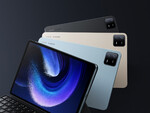Xiaomi Pad 6 Pro
Ausstattung / Datenblatt

Secondary Camera: 20 MPix f/2.2, 0.8µm
Preisvergleich
Durchschnitt von 1 Bewertungen (aus 6 Tests)
Testberichte für das Xiaomi Pad 6 Pro
Quelle: Tech Amaze
 EN→DE
EN→DEIn the software section, the balance does not lean much towards Xiaomi. The lack of features that we are used to seeing in Samsung’s Dex and iPad OS, deals a big blow to the user experience of the Pad 6 Pro, to the point that the differences between MIUI Pad and MIUI are almost negligible and we can’t consider it a separate personality from the user interface of Xiaomi smartphones. In terms of hardware performance, we see everything we expect from the Snappdragon 8+ Gen 1 chip in the Pad 6 Pro. Excellent performance stability, great performance in games and CPU tests can reassure us about the processing power of the Xiaomi tablet. Finally, we get to the discussion of the price of the Xiaomi tablet and its value for money. As we mentioned in the introduction and throughout the review, the price difference between the Pad 6 Pro and its rivals is quite noticeable. Keep in mind that Samsung gives you its tablets with a pen, but you have to pay a separate fee for Xiaomi’s Smart Pen (and of course the Xiaomi tablet keyboard) and Apple Pencil.
Einzeltest, online verfügbar, Sehr Lang, Datum: 01.02.2024
Quelle: TechTablets

Einzeltest, online verfügbar, Sehr Lang, Datum: 01.05.2023
Quelle: Igeekphone
 EN→DE
EN→DEHowever, the comments mentioned at the press conference do not occupy the screen and will pop up from the right. This point is not yet implemented in the current version and should be added in the subsequent official version. Fortunately, the mainstream long video platforms have already done an excellent job of horizontal screen adaptation, and there is no frame lock, and there is no obvious problem in the experience. Under the premise of the current Android tablet market environment, Mi Pad 6 Pro is a product that is stacked and balanced on the hardware as much as possible and gradually completes the functions and perfect experience on the software, which is commonly known as the bucket machine. As far as the results are concerned, the appearance design of the Xiaomi Pad 6 Pro is not very brilliant, but at least it can’t go wrong. The screen and performance experience is remarkable, andcan’ttexture of the accessories is further enhanced, making up for the shortcomings. It should be said. It is a more genuine product, and it is also a product suitable for a good life.
Einzeltest, online verfügbar, Mittel, Datum: 20.04.2023
Quelle: Root Nation PL
 PL→DE
PL→DEEinzeltest, online verfügbar, Lang, Datum: 02.08.2023
Bewertung: Gesamt: 70% Bildschirm: 70% Mobilität: 80% Gehäuse: 90%
Quelle: Unite4buy
 PL→DE
PL→DEPositive: Powerful hardware; high gaming performance; nice dual cameras; decent battery capacity; quick charging.
Einzeltest, online verfügbar, Mittel, Datum: 20.04.2023
Quelle: Viettelstore
 VN→DE
VN→DEPositive: Premium and modern design; nice display; powerful processor.
Hands-On, online verfügbar, Kurz, Datum: 23.05.2023
Kommentar
Modell: Xiaomi Pad 6 jetzt bei Amazon
Qualcomm Adreno 730: Grafikchip für Smartphones und Tablets, integriert im Qualcomm Snapdragon 8 Gen 1 SoC. Laut Qualcomm um 30% schneller als die alte Adreno 660 im Snapdragon 888.
Diese Klasse ist noch durchaus fähig neueste Spiele flüssig darzustellen, nur nicht mehr mit allen Details und in hohen Auflösungen. Besonders anspruchsvolle Spiele laufen nur in minimalen Detailstufen, wodurch die grafische Qualität oft deutlich leidet. Diese Klasse ist nur noch für Gelegenheitsspieler empfehlenswert. Der Stromverbrauch von modernen Grafikkarten in dieser Klasse ist dafür geringer und erlaubt auch bessere Akkulaufzeiten.
» Weitere Informationen gibt es in unserem Notebook-Grafikkartenvergleich und der Benchmarkliste.
SD 8+ Gen 1: High-End SoC (System on a Chip) für Smartphones welcher Ende 2021 vorgestellt wurde. Integriert unter anderen einen schnellen Cortex-X2 "Prime Core" mit bis zu 3,2 GHz und drei weitere schnelle Cortex-A710 basierende Performance-Kerne mit bis zu 2,5 GHz. Zum Stromsparen wurden außerdem 4 weitere ARM Cortex-A510 Kerne verbaut. Integriert ein 5G Modem, WiFi 6e und eine Hexagon AI Engine. Im Vergleich zum SD 8 Gen 1 bietet die Plus Version einen um 200 MHz höher getakteten Prime Core und einen 10% höheren GPU-Takt.» Weitere Infos gibt es in unserem Prozessorvergleich Vergleich mobiler Prozessoren und der Prozessoren Benchmarkliste .

